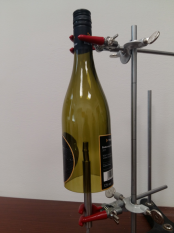
In situ measurement of light transmission into wine bottles and calculation of shelf life
The paper authored by Zs. Laposa,
S. Vesztergom, M. Kocsis and E. Keszei
is published in Oeno One (2023, vol. 57, pp. 265–277).
Abstract:
Wine exposed to UV-A and violet light (320–440 nm) can develop a light-struck flavour which deteriorates its quality. In a short introduction, we briefly describe the two most important photochemical pathways of this process and discuss conditions that facilitate the formation of undesired compounds. The main thrust of the study is to use a novel method to determine light transmission into real wine bottles, along with optical and photochemical modelling of wine damage. Calculation of light transmission into bottles and resulting photochemical damage is described in detail and compared to in situ measurements of transmitted light inside bottles. The effect of different light sources (sunlight, fluorescent bulbs and LED bulbs) is also discussed. It is found in in situ measurements that clear (flint) bottles transmit up to 35 % and bluish-green bottles up to 8 % of the harmful UV–violet light, while light amber bottles only up to 1.2 % and dark amber ones up to 0.2 %. Results of simple tasting experiments support the validity of shelf life calculations described here. According to these findings, white wine in flint (clear) and bluish-green bottles can survive only for a few days while displayed on shelves; light amber bottles conserve the quality for about a month and dark amber bottles for more than a year. Recommendations concerning the protection of shelf-displayed bottled wine from light exposure are also given.
